

Editor’s Note: This is the seventh installment in a series about home gun safes. The series will dive into detail about safe technology, mounting/hardening you safe, increased fire protection, specialty safes and higher-rated safes, and buying used safes. There is a lot of information to consider when buying a safe. Follow along with us as we take a deep dive into this subject.
SERIES:
- Part 1: Introduction to Gun Safes
- Part 2: Electronic/Biometric/Manual Locks
- Part 3: Anchoring Your Safe
- Part 4: Fireproofing Your Gun Safe
- Part 5: Understanding The Threats
- Part 6: Specialty Safes & Remodels
- Part 7: Quick-Access Safes
- Part 8: Buying & Selling Used Safes
- Part 9: Moisture, the Constant Battle
When you need your gun at 2 am, which small, quick-access safe will you want at your side? Is all this exciting fast-access technology reliable?
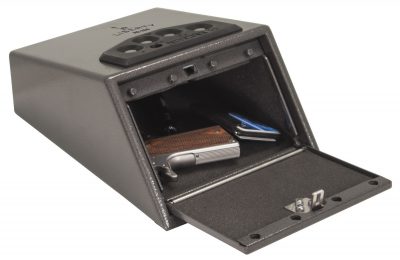
Quick-access safes, such as this Liberty Safe HD-200, offer security and rapid access in one package. Images courtesy of the manufacturers.
Quick Access is a term that is highly relative depending on the situation you’re applying it to. If you have eyes on the threat and know it is coming, minutes may be enough. If you’re in the middle of a blitz attack on your front door, the only access quick enough may be “on your person.” Most of us have tasks we must complete every single day that take us out of Condition Yellow, like sleeping or bathing. Although, I do have some friends that claim to sleep in Condition Yellow. When I hear this, I’m reminded of the Pink Panther movies, where Cato Fong is Clouseau’s manservant, trained to attack him regularly to keep him alert and skilled in martial arts. Considering that must of us don’t have access to such … “luxury,” we’ll call it … we must instead resort to boring, old preparedness and self-discipline.
In these times where we must disarm regularly, we need a secure way to keep our guns ready to bring into action. When we consider the importance of Quick Access in our list of criteria for a self-defense weapon, handguns become easy front-runners.
First, we should look at the choice of locks that are currently offered. The lock will affect price, convenience, speed, and reliability.
Biometric Entry
Biometric entry systems use fingerprint identification to open the lock. You can program multiple “key” prints that will open the safe; these can be yours, and those of any other trusted person you choose. Most of us have or have seen this feature on a smartphone or laptop. When someone presses their finger, the system knows whether to pop the lock for them.
Advantages are clear: no combinations to forget or fumble under stress. With a safe like the HDX-250 from Liberty, you have ultra-fast access you can control. Also, you can allow access to others or take it away as you see fit.
There are potential disadvantages, though. Loss of power to the reader can render the safe inaccessible. Your print can become unreadable due to an injury to the digit. Blood or other liquids can also obscure your print; you’d better hope you don’t find yourself running for your safe while knee-deep in dirty yard work. There are plenty of common scenarios that could deprive you access to your weapon when it’s behind a biometric lock. It’s also worth noting that this is currently the most expensive lock choice on the market.
Quick Combo Vaults
Use keypads with a pin number for entry. These come in two forms: electronic buttons or mechanical buttons. Both are programmable and offer quick access, but require you to input a series or combinations of button pushes to open. A good example of a model with electronic buttons is the Liberty HD-200.
Radio Frequency Identification (RFID)
Radio Frequency Identification (RFID) locks use a key fob or card for entry. With RFID technology, you can wear the key on your body, on something like a bracelet. You can also affix a dot to your smartphone that will activate the safe. A credit card can be carried in your wallet, which can be swiped over the reader to unlock the safe. You could go with a fob attached to your key chain. You have the option of having multiple keys that can open the safe, so that one is always conveniently placed or carried. A good example is the Hornady RAPiD Safe line.
The advantages of RFID are accessibility and simplicity; simply get the chip close to the lock and it opens. There’s nothing to insert or remember, and there are very few circumstances that could render it unusable.
Much like a key safe, you have the disadvantage of having to carry something, or remember where it is (and have it nearby). Loss of power would also be a consideration with this type of lock, although most of these safes offer a regular key and/or a combination that can be entered, providing some workarounds to these problems.
Key Locks
The classic key lock is simple. Insert key, turn, open door. Done. A great example is the Liberty HD-90.
The advantage is that if you have the key, not much can go wrong. This will also be the least expensive option.
Of course, if you don’t have the key, you don’t have the gun. Under stress, inserting a key and turning can become time-consuming and cumbersome. As silly as it may seem, the act of unlocking with a key is a fine motor skill, and our brains can turn to absolute mush when that adrenaline kicks in. It’s called “Fight or flight,” not “Fight or Stop and Focus on Very Quickly Performing Fine Motor Skills Efficiently.”
Door Opening
Once you’ve opened the lock, you still must get the gun out. This is an easy point to overlook until you’ve had some experience with the options for doing so. How do you want to retrieve the gun?
A manual door requires you to open the door with your hand before getting access to your gun. What I will call the auto open category, forces the door open when the lock is released. Safes like this are driven by a hydraulic ram, much like the mechanism that opens a trunk lid or rear door on a car. There are also a couple of options for delivery of the gun. You could have it lying horizontally on the floor of the safe, or on a shelf. But there are also holders that you can attach to the safe and place your pistol into, so that when the door opens the gun is presented, butt up and ready to draw. Also, some safes are designed to orient the firearm a particular way when opened. Again: it is always worth considering options to remove any potential fumbling or “micro-tasking” to accommodate a stressed-out brain.
Size
Size always matters. In this case, size determines where you can place the safe, and what you can put in it. I know from experience that a light (in addition to a weapon-mounted light) and a reload will be welcome accessories if you need to grab your gun and go out into the dark. In fact, the list of items that are nice to have for quick access could fill a separate article all on its own. What you deem to be essential will, in large part, determine how large of a safe you need.
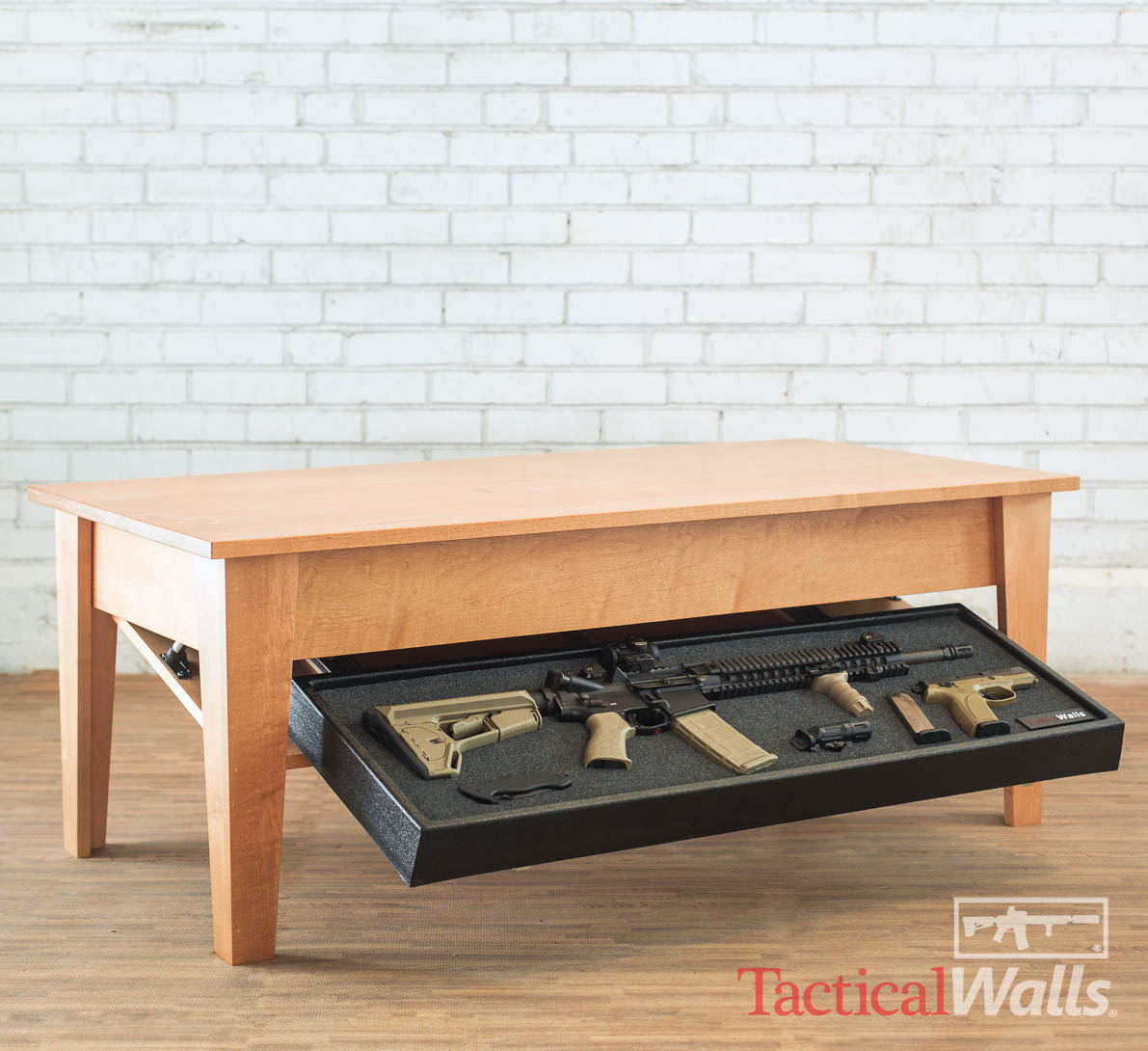
You can have immediate access to a firearm through the use of hidden storage such as with this Tactical Walls Concealment Coffee Table.
Location
The safe’s future home must be factored into the purchasing decision. Most personal safes are either in a home or inside of a vehicle. The great news is that these days, you have more choices than ever when it comes to making your chosen location work.
Vehicle safes have come a long way. There are plenty of one-size-fits-all jobs, as well as a plethora of customizable options out there. Even a simple and inexpensive safe that holds your gun and slips under your seat is a much better choice than simply leaving your gun in the glove box. Custom safes exist that fit in the center console, mount under the seat, or install in other specific locations, based on your vehicle.
In your home, the choices are all yours. Whether you want to mount your safe to the side of your bed frame, beside the bed on a nightstand, in a drawer, or behind a painting of a dock like you’re Colonel Mustard in the study with the revolver, there’s a company out there that will sell you a solution. The options are endless, with safes that look like (and technically are) quality furniture, keeping your gun in reach and securely out of site. A great example are the Tactical Walls series of products, such as the Concealment Coffee Table.
Handgun Vault Accessories
The required accessories for mounting a safe are minimal, and based on what you buy and where you mount, there could be none. That is one of the nice things about handgun safes; one and done tends to be the norm.
Mounting brackets allow you to secure the safe in your home or car. A cable lock can help with temporary mounting, somewhere like inside of a rental car or hotel room.
A power supply can serve to keep batteries fresh and, in some cases, will make the safe quicker to open. Plenty of safes have a light that comes on when the door is opened, to help you find your gun. If yours does not have such a light, think about mounting a small motion-activated LED.
A Few Pitfalls
As safes have more and more advanced technology crammed into them in the name of quick access, their potential failure rates go up. Let’s be real, these safes are all sold at such a price point that they’re all using the same or equivalent consumer-grade technology in the locks. My point is that these quick access handgun safes are not lifetime purchases, but rather semi-durable items. You have to think outside the box when weighing your options with these, compared to your two-ton chunk of reliable iron securing your rifles.
There are plenty of choices, so get creative and hunt down the exact one you need for the application you want it for. Don’t be scared to buy more than one, as the safe is just like real estate: It’s all about location, location, location.
For more information, visit https://www.libertysafe.com/.
To purchase a Liberty Safe product on GunsAmerica.com, click this link: https://www.gunsamerica.com/Search.htm?Keyword=liberty<id-all=1&as=730&cid=825&ns=0&numberperpage=50&.
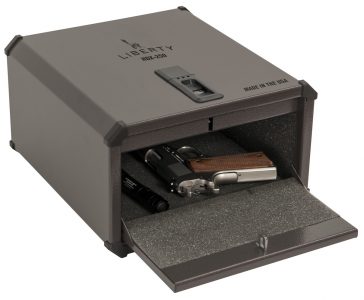
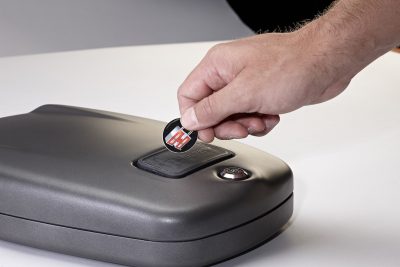
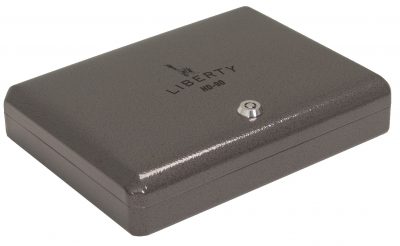
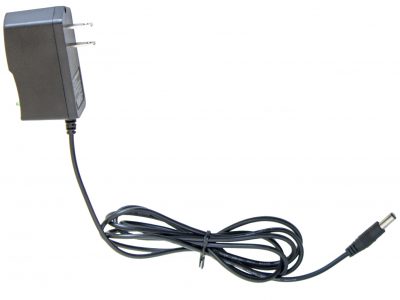
I have the shot lock mechanical pistol safe. Absolutely love it. In fact I have three. The biggest plus for me being over 60 years old is that biometric safes sometimes won’t accept a fingerprint scan (Something to do with thinner skin) so I stopped using them. Mechanical works just fine. the biggest concern for me is keeping my handguns away from small fingers. It’s perfect for that and it also allows quick access. I keep my pistols for home defense in pistol safes. everything else goes into my regular gun safe.
People knock cannon safes, but I have this exact safe and I love it. People say it can be pried into or cut open and this and that, well most safes can but this safe will prevent a smash and grab type burglary. We also have a home security system so with that added your typical smash and grab robber isn’t trying to crack into a safe and your home security system will not allow them enough time to do so. It also keeps nosey people and children from getting access to your valuables and guns. It’s a great safe for the money. As for fire protection.. who REALLY knows the truth behind a safes fire protection claims. There will always be what-ifs or this and that is better. it’s a great safe.
I own and use all three types and I STRONGLY recommend an RFID with keypad and key. RFID is fast and reliable where the biometric is too prone failure from dirty fingers. The keypad is great should you not have the RFID with you. The key is the slowest but failSAFE.
As the owner of a biometric type gun safe, I can state categorically that I would not ever rely on it for “fast” entry. The reader is just too unreliable and at times, just plain slow. To try and circumvent the reliability issue, I tried programing in several different “users” using the same finger, swiping it in slightly different orientations and motions. After doing this for 10 different users, the box will now normally open on the first try with the key word being ‘normally’. Instead of relying on it’s unreliability, I now open it when I go to bed and close it back again when I get up.